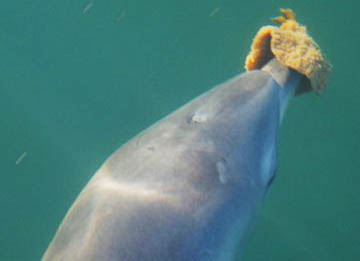Dolphins Go Sponging To Trace Food
 It is a well known fact that a selected species of animals including humans, use tools in order to find food. The selected list of species include birds, great apes and the latest member to join this club is the species of bottlenose dolphin belonging to a small subset of the Western Australia Indian Ocean.
It is a well known fact that a selected species of animals including humans, use tools in order to find food. The selected list of species include birds, great apes and the latest member to join this club is the species of bottlenose dolphin belonging to a small subset of the Western Australia Indian Ocean.
It has been discovered that these bottlenose dolphins use sponges to find food on the sea floor. Furthermore, it has also been found that the dolphins that engage in this activity become ‘workaholics’, putting in long hours as they root about for food.
On Tuesday evening, the details related to the latest research were released online on the freely available PLoS One. Any one and everyone can get access to the latest research as it is provided free by the Public Library of Science.
A group of dolphins in Shark Bay were studied for more than two decades by a team led by Prof Janet Mann of Georgetown University.
Prof Mann informed, “It turns out the brainiacs of the marine world can also be tool-using workaholics, spending more time hunting with tools than any non-human animal. This is the first and only clear case of tool use by a wild dolphin or whale.”
It was also found by Prof Mann that not all dolphins use this technique as she found only 41 dolphins in a population numbering into the thousands that used marine sponges as a foraging tool on the sea floor.
“They use the sponge to clear away sand and debris to expose burrowing prey. The technique is demanding however, given those dolphins who adopt it, tend to spend more time hunting and diving and tend to dive for longer periods than the bottlenoses that do not use sponges for foraging,” she added.
It was noted by her that those who tend to use sponge tools in this way; become more solitary than their peers. Further more, they spent more time in deep-water channel habitats and less time socializing. However, this did not affect their ability to reproduce.
It was also discovered that most of the spongers were females and they were able to transfer this behavior to their babies.
It was discovered by Prof Mann and co-authors that female calves readily started sponging, but male calves seldom used sponges and if they did, they began much later.
She said, “While a few males carry sponges, they seem to be slow-learners in this regard.”